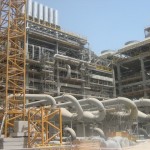 Natural gas fell on Friday and settled the week lower after the EIA reported on Thursday the 22nd straight above-average inventory gain and as weather forecasts pointed to moderating temperatures next week.
Natural gas fell on Friday and settled the week lower after the EIA reported on Thursday the 22nd straight above-average inventory gain and as weather forecasts pointed to moderating temperatures next week.
On the New York Mercantile Exchange, natural gas futures for delivery in October lost 1.87% on Friday to settle the week 0.4% lower at $3.837 per million British thermal units, having ranged between Wednesdays two-week high of $4.040 and a weekly low of $3.834, reached on Friday.
Traders bought into the contract through the middle of the week as cool overnight lows in some parts of the US, including the Midwest, incited some heating demand. However, weather forecasting agencies predicting that the early winter heating demand is expected to be short-lived, coupled with a yet another above-average weekly build in US natural gas inventories, pushed the contract into negative weekly territory.
“Until weather patterns turn convincingly colder, we see little reason to buy into early winter season hype, especially with two months still to go in the build season,” analysts at NatGasWeather.com wrote in a note to clients on Friday. “Expect deficits to continue making up ground in steady chunks for the next three weeks, and potentially a while longer.”
The US Energy Information Administration (EIA) reported the build at natural gas inventories for the week ended September 12th to be quite larger than expected at 90 billion cubic feet (Bcf), which was also the the lower end of analysts’ forecasts. This compared to a 48-bcf build a year earlier and the five-year average gain pace of 71 billion cubic feet. The figure also represents the 22nd straight week of above-average injections and narrowed the deficit to the same-week 5-year average to just 13.3% at 2.891 trillion cubic feet of natural gas in storage. The series also logs the highest 20-week build in more than 20 years.
A fast moving weather system will track across the Midwest and Northeast early next week, driving some light heating demand. This, however, will likely be the last somewhat chilly weather system over the central and eastern US until October, as it will be followed by much warmer comfortable temperatures.
“Temperatures in the 70s and 80s will rule. The US [with the brief exception of the Northeast] should require limited heating or cooling demand in this warm early fall pattern,” NatGasWeather.com wrote.
According to AccuWeather.com, the high in New York on September 23rd will be 71 degrees Fahrenheit, 1 below average, before jumping to 77-80 degrees late next week. Chicago will see sunny weather on September 22nd, with highs at about 62 degrees, which will be well below the average of 73 degrees. A decent warm-up is expected to follow, with highs reaching 72-73 degrees Fahrenheit between September 25th and September 29th, exceeding seasonal values by about 1-3 degrees.
Down South, Houston will enjoy mostly sunny and pleasant weather on September 23rd. Highs will reach 85 degrees, compared to the average of 87, before jumping to as much as 90-91 degrees on September 28th-29th. On the West Coast, the high in Los Angeles on September 24th will be 86 degrees, 4 above normal, before dropping next Saturday to 80 degrees, 1 below usual.
Technical support and resistance levels
According to Binary Tribune’s daily analysis for Monday, October natural gas futures’ central pivot point stands at $3.864. In case the contract penetrates the first resistance level at $3.895 per million British thermal units, it will encounter next resistance at $3.952. If breached, upside movement will probably attempt to advance to $3.983 per mBtu.
If the energy source drops below its first support level at $3.807 per mBtu, it will next see support at $3.776. If the second key support zone is breached, the power-station fuel’s downward movement may extend to $3.719 per mBtu.
In weekly terms, the central pivot point is at $3.904. The three key resistance levels are as follows: R1 – $3.973, R2 – $4.110, R3 – $4.179. The three key support levels are: S1 – $3.767, S2 – $3.698, S3 – $3.561.





